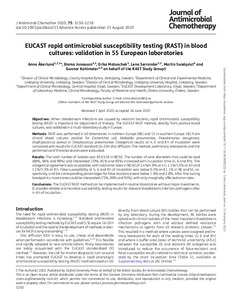| dc.contributor.author | Vennberg L. | |
| dc.contributor.author | Åkerlund A. | |
| dc.contributor.author | Kahlmeter G; the RAST Study Group | |
| dc.contributor.author | Jonasson E. | |
| dc.contributor.author | Akyar I. | |
| dc.contributor.author | Hazirolan G. | |
| dc.contributor.author | Gelmez G.A. | |
| dc.contributor.author | Kaygisiz A.N.S. | |
| dc.date.accessioned | 2022-10-28T14:18:12Z | |
| dc.date.available | 2022-10-28T14:18:12Z | |
| dc.identifier.uri | https://www.utupub.fi/handle/10024/170570 | |
| dc.description.abstract | <p><strong>Objectives: </strong>When bloodstream infections are caused by resistant bacteria, rapid antimicrobial susceptibility testing (RAST) is important for adjustment of therapy. The EUCAST RAST method, directly from positive blood cultures, was validated in a multi-laboratory study in Europe.</p><p><strong>Methods: </strong>RAST was performed in 40 laboratories in northern Europe (NE) and 15 in southern Europe (SE) from clinical blood cultures positive for Escherichia coli, Klebsiella pneumoniae, Pseudomonas aeruginosa, Staphylococcus aureus or Streptococcus pneumoniae. Categorical results at 4, 6 and 8 h of incubation were compared with results for EUCAST standard 16-20 h disc diffusion. The method, preliminary breakpoints and the performance of the laboratories were evaluated.</p><p><strong>Results: </strong>The total number of isolates was 833/318 in NE/SE. The number of zone diameters that could be read (88%, 96% and 99%) and interpreted (70%, 81% and 85%) increased with incubation time (4, 6 and 8 h). The categorical agreement was acceptable, with total error rates in NE/SE of 2.4%/4.9% at 4 h, 1.1%/3.5% at 6 h and 1.1%/3.3% at 8 h. False susceptibility at 4, 6 and 8 h of incubation was below 0.3% and 1.1% in NE and SE, respectively, and the corresponding percentages for false resistance were below 1.9% and 2.8%. After fine-tuning breakpoints, more zones could be interpreted (73%, 89% and 93%), with only marginally affected error rates.</p><p><strong>Conclusions: </strong>The EUCAST RAST method can be implemented in routine laboratories without major investments. It provides reliable antimicrobial susceptibility testing results for relevant bloodstream infection pathogens after 4-6 h of incubation.</p> | |
| dc.language.iso | en | |
| dc.publisher | Oxford University Press | |
| dc.title | EUCAST rapid antimicrobial susceptibility testing (RAST) in blood cultures: Validation in 55 european laboratories | |
| dc.identifier.urn | URN:NBN:fi-fe2021042826001 | |
| dc.relation.volume | 75 | |
| dc.contributor.organization | fi=tyks, vsshp|en=tyks, vsshp| | |
| dc.converis.publication-id | 52228007 | |
| dc.converis.url | https://research.utu.fi/converis/portal/Publication/52228007 | |
| dc.format.pagerange | 3230 | |
| dc.format.pagerange | 3238 | |
| dc.identifier.eissn | 1460-2091 | |
| dc.identifier.jour-issn | 0305-7453 | |
| dc.okm.affiliatedauthor | Dataimport, tyks, vsshp | |
| dc.okm.discipline | 3111 Biolääketieteet | fi_FI |
| dc.okm.discipline | 3111 Biomedicine | en_GB |
| dc.okm.internationalcopublication | international co-publication | |
| dc.okm.internationality | International publication | |
| dc.okm.type | Journal article | |
| dc.publisher.country | Britannia | fi_FI |
| dc.publisher.country | United Kingdom | en_GB |
| dc.publisher.country-code | GB | |
| dc.relation.doi | 10.1093/jac/dkaa333 | |
| dc.relation.ispartofjournal | Journal of Antimicrobial Chemotherapy | |
| dc.relation.issue | 11 | |
| dc.year.issued | 2020 | |
